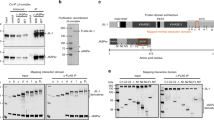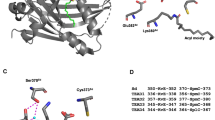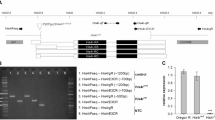Abstract
STAT (Signal transducer and activator of transcription) is a potent transcription factor and its aberrant activation by phosphorylation is associated with human cancers1,2,3,4. We have shown previously that overactivation of JAK, which phosphorylates STAT5,6, disrupts heterochromatin formation globally in Drosophila melanogaster7. However, it remains unclear how this effect is mediated and whether STAT is involved. Here, we demonstrate that Drosophila STAT (STAT92E) is involved in controlling heterochromatin protein 1 (HP1) distribution and heterochromatin stability. We found, unexpectedly, that loss of STAT92E, had the same effects as overactivation of JAK in disrupting heterochromatin formation and heterochromatic gene silencing, whereas overexpression of STAT92E had the opposite effects. We have further shown that the unphosphorylated or 'transcriptionally inactive' form of STAT92E is localized on heterochromatin in association with HP1, and is required for stabilizing HP1 localization and histone H3 Lys 9 methylation (H3mK9) . However, activation by phosphorylation reduces heterochromatin-associated STAT92E, causing HP1 displacement and heterochromatin destabilization. Thus, reducing levels of unphosphorylated STAT92E, either by loss of STAT92E or increased phosphorylation, causes heterochromatin instability. These results suggest that activation of STAT by phosphorylation controls both access to chromatin and activity of the transcription machinery.
This is a preview of subscription content, access via your institution
Access options
Subscribe to this journal
Receive 12 print issues and online access
$209.00 per year
only $17.42 per issue
Buy this article
- Purchase on Springer Link
- Instant access to full article PDF
Prices may be subject to local taxes which are calculated during checkout





Similar content being viewed by others
References
Bromberg, J. Stat proteins and oncogenesis. J. Clin. Invest. 109, 1139–1142 (2002).
Yu, H. & Jove, R. The STATs of cancer — new molecular targets come of age. Nature Rev. Cancer 4, 97–105 (2004).
Aaronson, D. S. & Horvath, C. M. A road map for those who know JAK-STAT. Science 296, 1653–1655 (2002).
Darnell, Jr, J. E., Kerr, I. M. & Stark, G. R. Jak-STAT pathways and transcriptional activation in response to IFNs and other extracellular signaling proteins. Science 264, 1415–1421 (1994).
Harrison, D. A., Binari, R., Nahreini, T. S., Gilman, M. & Perrimon, N. Activation of a Drosophila Janus kinase (JAK) causes hematopoietic neoplasia and developmental defects. EMBO J. 14, 2857–2865 (1995).
Luo, H., Hanratty, W. P. & Dearolf, C. R. An amino acid substitution in the Drosophila hopTum-l Jak kinase causes leukemia-like hematopoietic defects. EMBO J. 14, 1412–1420 (1995).
Shi, S. et al. JAK signaling globally counteracts heterochromatic gene silencing. Nature Genet. 38, 1071–1076 (2006).
Hanratty, W. P. & Dearolf, C. R. The Drosophila Tumorous-lethal hematopoietic oncogene is a dominant mutation in the hopscotch locus. Mol. Gen. Genet. 238, 33–37 (1993).
Betz, A. & Darnell, Jr, J. E. A Hopscotch-chromatin connection. Nature Genet. 38, 977–979 (2006).
Arbouzova, N. I. & Zeidler, M. P. JAK/STAT signalling in Drosophila: insights into conserved regulatory and cellular functions. Development 133, 2605–2616 (2006).
Hou, S. X., Zheng, Z., Chen, X. & Perrimon, N. The Jak/STAT pathway in model organisms. Emerging roles in cell movement. Dev. Cell 3, 765–778 (2002).
Grewal, S. I. & Elgin, S. C. Heterochromatin: new possibilities for the inheritance of structure. Curr. Opin. Genet. Dev. 12, 178–187 (2002).
James, T. C. et al. Distribution patterns of HP1, a heterochromatin-associated nonhistone chromosomal protein of Drosophila. Eur. J. Cell Biol. 50, 170–180 (1989).
Li, Y., Danzer, J. R., Alvarez, P., Belmont, A. S. & Wallrath, L. L. Effects of tethering HP1 to euchromatic regions of the Drosophila genome. Development 130, 1817–1824 (2003).
Kaminker, J. S. et al. The transposable elements of the Drosophila melanogaster euchromatin: a genomics perspective. Genome Biol. 3, 0084.1–0084.20 (2002).
Sun, F. L. et al. cis-Acting determinants of heterochromatin formation on Drosophila melanogaster chromosome four. Mol. Cell Biol. 24, 8210–8220 (2004).
De Lucia, F., Ni, J. Q., Vaillant, C. & Sun, F. L. HP1 modulates the transcription of cell-cycle regulators in Drosophila melanogaster. Nucleic Acids Res. 33, 2852–2858 (2005).
Kellum, R., Raff, J. W. & Alberts, B. M. Heterochromatin protein 1 distribution during development and during the cell cycle in Drosophila embryos. J. Cell Sci. 108, 1407–1418 (1995).
Shareef, M. M. et al. Drosophila heterochromatin protein 1 (HP1)/origin recognition complex (ORC) protein is associated with HP1 and ORC and functions in heterochromatin-induced silencing. Mol. Biol. Cell 12, 1671–1685 (2001).
Liu, L., McBride, K. M. & Reich, N. C. STAT3 nuclear import is independent of tyrosine phosphorylation and mediated by importin-α3. Proc. Natl Acad. Sci. USA 102, 8150–8155 (2005).
Karsten, P., Plischke, I., Perrimon, N. & Zeidler, M. P. Mutational analysis reveals separable DNA binding and trans-activation of Drosophila STAT92E. Cell Signal. 18, 819–829 (2006).
Thiru, A. et al. Structural basis of HP1/PXVXL motif peptide interactions and HP1 localisation to heterochromatin. EMBO J. 23, 489–499 (2004).
Li, J. et al. Patterns and functions of STAT activation during Drosophila embryogenesis. Mech. Dev. 120, 1455–1468 (2003).
Li, W. X., Agaisse, H., Mathey-Prevot, B. & Perrimon, N. Differential requirement for STAT by gain-of-function and wild-type receptor tyrosine kinase Torso in Drosophila. Development 129, 4241–4248. (2002).
Sweitzer, S. M., Calvo, S., Kraus, M. H., Finbloom, D. S. & Larner, A. C. Characterization of a Stat-like DNA binding activity in Drosophila melanogaster. J. Biol. Chem. 270, 16510–16513 (1995).
Dorer, D. R. & Henikoff, S. Expansions of transgene repeats cause heterochromatin formation and gene silencing in Drosophila. Cell 77, 993–1002 (1994).
Ronsseray, S., Boivin, A. & Anxolabehere, D. P-Element repression in Drosophila melanogaster by variegating clusters of P-lacZ-white transgenes. Genetics 159, 1631–1642 (2001).
Acknowledgements
We thank J. Birchler, S. Elgin, S. Hou, L. Wallrath, M. Zeidler, G. Reuter, the Developmental Hybridoma Bank (Iowa), the Bloomington Drosophila Stock Center for Drosophila strains and reagents and H. Land and D. Bohmann for helpful comments on the manuscript. This study was supported, in part, by grants from the National Institutes of Health (R01GM65774; R01GM077046), an American Cancer Society Research Scholar Grant (RSG-06-196-01-TBE) and a Leukemia & Lymphoma Society Research Scholar Grant (1087-08) to W.X.L.
Author information
Authors and Affiliations
Contributions
W. X. L. conceived and designed the experiments; S. S., K. L., D. G., S. J. L., P. D. and S.-J. Y. performed the experiments and analysed the data; W. X. L. wrote the paper.
Corresponding author
Supplementary information
Supplementary Information
Supplementary Figures S1, S2, S3, S4, S5, S6 and S7 (PDF 877 kb)
Rights and permissions
About this article
Cite this article
Shi, S., Larson, K., Guo, D. et al. Drosophila STAT is required for directly maintaining HP1 localization and heterochromatin stability. Nat Cell Biol 10, 489–496 (2008). https://doi.org/10.1038/ncb1713
Received:
Accepted:
Published:
Issue Date:
DOI: https://doi.org/10.1038/ncb1713
This article is cited by
-
The JAK/STAT signaling pathway: from bench to clinic
Signal Transduction and Targeted Therapy (2021)
-
Molecular effects of dADD1 misexpression in chromatin organization and transcription
BMC Molecular and Cell Biology (2020)
-
Unphosphorylated STAT3 in heterochromatin formation and tumor suppression in lung cancer
BMC Cancer (2020)
-
The mouse HP1 proteins are essential for preventing liver tumorigenesis
Oncogene (2020)
-
Streptonigrin at low concentration promotes heterochromatin formation
Scientific Reports (2020)



